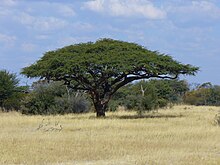Vachellia erioloba
| Vachellia erioloba | |
|---|---|
 |
|
| Vachellia erioloba Camel Thorn | |
 |
|
| Seeds and pods | |
| Scientific classification | |
| Kingdom: | Plantae |
| (unranked): | Angiosperms |
| (unranked): | Eudicots |
| (unranked): | Rosids |
| Order: | Fabales |
| Family: | Fabaceae |
| Genus: | Vachellia |
| Species: | V. erioloba |
| Binomial name | |
|
Vachellia erioloba (E.Mey.) P.J.H.Hurter |
|
| Synonyms | |
|
|
Vachellia erioloba (camel thorn, giraffe thorn) is a tree of southern Africa in the family Fabaceae. Its preferred habitat is the deep dry sandy soils in parts of South Africa, Botswana, the western areas of Zimbabwe and Namibia. It is also native to Angola, south-west Mozambique, Zambia and Swaziland. The tree was first described by Ernst Heinrich Friedrich Meyer and Johann Franz Drège in 1836. The camel thorn is a protected tree in South Africa.
The tree can grow up to 17 metres high. It is slow-growing, very hardy to drought and fairly frost-resistant. The wood is dark reddish-brown in colour and extremely dense and strong. It is a good for fires, which leads to widespread clearing of dead trees and the felling of healthy trees. It produces ear-shaped pods, favoured by a large number of herbivores including cattle. The seeds can be roasted and used as a substitute for coffee beans.
The name 'camel thorn' refers to the fact that giraffe (kameelperd in Afrikaans) commonly feed on the leaves with their specially-adapted tongue and lips that can avoid the thorns. The scientific name 'erioloba' means "wooly lobe", a reference to the ear-shaped pods
The pods of the Camel thorn, while they remain on a tree (near Potgietersrust in Transvaal, South Africa)
Vachellia erioloba seeds, lying upon the ground, scattered among their pods, Sossusvlei, Namib Desert, Namibia
...
Wikipedia
